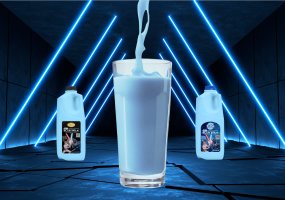High-fructose corn syrup (HFCS) linked to the obesity crisis and a staple in American diets, is metabolized just like the fructose in fruit, but with some significant differences. The first is that fruit is packed with additional nutrients, such as vitamins, minerals, and fiber, which regulate digestion and metabolism.
Soda, which is sweetened with HFCS, has no fiber or any other nutrient contribution other than calories. And a soda that is sweetened with 100 percent HFCS delivers far more fructose than a piece of fruit: A 2 1/2 inch peach has 13 grams of sugar, of which only 2.4 grams are fructose. A 20-ounce bottle of soda contains about 33 grams of fructose.
In the 1970s, sugar prices soared, making the cost of foods that depended on sugar cane almost unaffordable. As a result, food technologists found a way to make a cheaper, sweeter sweetener by transforming corn into HFCS. When HFCS was first introduced, few scientists questioned the effect that so much fructose would have on people's health.
HFCS has a carbohydrate profile similar to regular table sugar. Both contain about 50 percent glucose and 50 percent fructose.
The most dramatic result of HFCS entering the food supply was its effect on the soft-drink industry. The availability of a low-priced sweetener meant that the cost of ingredients was so minimal that soft-drink manufacturers could practically give the stuff away. That's what happened at many fast-food restaurants and movie theatres.
For pennies, restaurants could up-size your soda order to a pound-size serving. This kind of value marketing brings traffic to the establishments and, unfortunately, additional calories to the American diet.
In addition to being an ingredient in soft drinks, HFCS is in candy, popsicles, pancake syrup, fruit-flavored yogurt, sweetened cereals, some pasta sauces, and apple juice. The enormous amount of HFCS in the American diet is worrying health scientists, because fructose has a unique metabolic response. It's clear in animal studies, but less so in humans, that fructose induces high blood pressure, high triglycerides (a form of fat in the blood associated with heart disease), impaired glucose tolerance (precursor to diabetes), and insulin resistance.
Some evidence suggests that fructose may cause weight gain and fat storage in humans, because it's metabolized into fat in the liver, rather than absorbed and processed into glucose the way that table sugar or other carbohydrates are. Additionally, because fructose doesn't stimulate insulin production, and therefore, leptin (hormone that increases after eating, turning off any feeling of hunger) concentrations remain low, you may still feel hungry even after consuming hundreds of calories from a soda.









